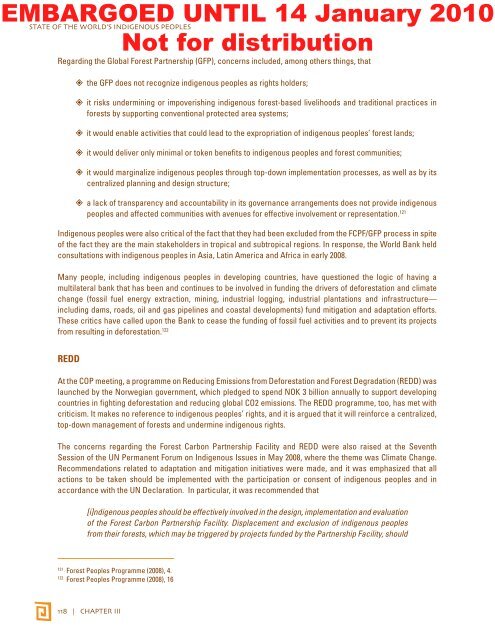STATE OF THE WORLD's INDIGENOUs PEOpLEs - CINU
STATE OF THE WORLD's INDIGENOUs PEOpLEs - CINU
STATE OF THE WORLD's INDIGENOUs PEOpLEs - CINU
- No tags were found...
You also want an ePaper? Increase the reach of your titles
YUMPU automatically turns print PDFs into web optimized ePapers that Google loves.
EMBARGOED UNTIL 14 January 2010<strong>STATE</strong> <strong>OF</strong> <strong>THE</strong> WORLD’S INDIGENOUS PEOPLESNot for distributionRegarding the Global Forest Partnership (GFP), concerns included, among others things, that the GFP does not recognize indigenous peoples as rights holders; it risks undermining or impoverishing indigenous forest-based livelihoods and traditional practices inforests by supporting conventional protected area systems; it would enable activities that could lead to the expropriation of indigenous peoples’ forest lands; it would deliver only minimal or token benefits to indigenous peoples and forest communities; it would marginalize indigenous peoples through top-down implementation processes, as well as by itscentralized planning and design structure; a lack of transparency and accountability in its governance arrangements does not provide indigenouspeoples and affected communities with avenues for effective involvement or representation. 121Indigenous peoples were also critical of the fact that they had been excluded from the FCPF/GFP process in spiteof the fact they are the main stakeholders in tropical and subtropical regions. In response, the World Bank heldconsultations with indigenous peoples in Asia, Latin America and Africa in early 2008.Many people, including indigenous peoples in developing countries, have questioned the logic of having amultilateral bank that has been and continues to be involved in funding the drivers of deforestation and climatechange (fossil fuel energy extraction, mining, industrial logging, industrial plantations and infrastructure—including dams, roads, oil and gas pipelines and coastal developments) fund mitigation and adaptation efforts.These critics have called upon the Bank to cease the funding of fossil fuel activities and to prevent its projectsfrom resulting in deforestation. 122REDDAt the COP meeting, a programme on Reducing Emissions from Deforestation and Forest Degradation (REDD) waslaunched by the Norwegian government, which pledged to spend NOK 3 billion annually to support developingcountries in fighting deforestation and reducing global CO2 emissions. The REDD programme, too, has met withcriticism. It makes no reference to indigenous peoples’ rights, and it is argued that it will reinforce a centralized,top-down management of forests and undermine indigenous rights.The concerns regarding the Forest Carbon Partnership Facility and REDD were also raised at the SeventhSession of the UN Permanent Forum on Indigenous Issues in May 2008, where the theme was Climate Change.Recommendations related to adaptation and mitigation initiatives were made, and it was emphasized that allactions to be taken should be implemented with the participation or consent of indigenous peoples and inaccordance with the UN Declaration. In particular, it was recommended that[i]ndigenous peoples should be effectively involved in the design, implementation and evaluationof the Forest Carbon Partnership Facility. Displacement and exclusion of indigenous peoplesfrom their forests, which may be triggered by projects funded by the Partnership Facility, should121Forest Peoples Programme (2008), 4.122Forest Peoples Programme (2008), 16118 | CHAPTER III
















